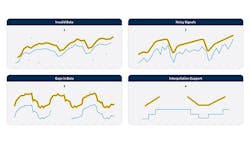Though the migration to cloud-based data processing and analytics has been underway for several years, the COVID-19 pandemic has turned a march to the cloud and digitalization into a stampede. "COVID-19 equals the cloud. It's gone from 3% of our business to 50%," says Michael Risse, VP and CMO at Seeq. "The pandemic caused users to throw out all their old rules about cloud adoption or avoidance. Remote workers everywhere need the cloud to connect to their data and analytics, so IT departments have been scrambling to deploy solutions on Microsoft Azure, Amazon Web Services (AWS) and other cloud platforms."
Risse reports there are two conversations on using the cloud for analytics with process applications and plants, and they involve different challenges and cloud-based architectures. "The first talk is fairly easy because it's about greenfield facilities and sensors, which enable 'born in the cloud' data that goes straight to the cloud," says Risse. "The second conversation is about brownfield plants with legacy sensors, SCADA systems and other devices, which present different challenges, especially when users want to look at different plants and compare practices across entire fleets and enterprises.”
For both scenarios, an important consideration is what needs to be done to the data—and how to cleanse it—before moving it to the cloud. Risse strongly advises that any data preparation should be part of the analysis process and not done in advance. “This is crucial because, if users clean or preprocess their data too early, they might remove details or something that could add value later, even though they won't know what it is until the data is analyzed," he explains.
Risse stresses it's also crucial to determine what type of data cleansing is most suitable based on the needs of each application and its organization's goals. The four main types of data cleaning Seeq can perform at the point of analysis are: smoothing noisy signals that could cause useful trends to be overlooked; removing or replacing invalid data that may also cause trends to be missed; filling in data gaps to complete a trend; and providing interpolation support to show trends in less granular data (Figure 1).
"Ninety-eight percent of the world's manufacturing data is still on-premise in brownfield facilities, and most sensors are still wired to historians," he says. "The best practice is to maintain full access and fidelity to all available data. And, if you get the chance to send it to the cloud, be aware of implications of the analytics you'll enable—or what you may limit."
By running in the cloud, Seeq's analytics software can reach down and connect to onsite historians and data sources, which means data doesn’t have to venture to the cloud to be used in analytics. "The assumption is often that users must move their data to the cloud for analysis to gain value, but this takes time and quickly gets expensive. The truth is that it's OK to keep data onsite," says Risse. "For example, Shell Oil Co. runs Seeq as a software as a service (SaaS) and connects with its OSIsoft PI Historian collectives. Once we connect to one or more information sources, Seeq can create a virtual data lake experience for users. This combination includes access to time-series data, contextualization data sources, and support for SQL databases, batch systems and manufacturing execution systems (MES), too.
"Users can also add new sensors and produce new data to analyze, but hopefully they'll also have a plan for what they'll be looking at. This will help define an overall data strategy about what and how much data to analyze, and how much will be worth spending on it. If a process application already has I/O, PLCs and a DCS, as almost all of them do, then adding Ethernet and an Internet protocol (IP) link to the cloud isn't doing an end run on the older system. This new connection and data that comes together in the cloud is a complement to the legacy network. Likewise, if a customer has wired sensors in place, then new wireless sensors enable them achieve a more holistic view of their plant, assets, and processes—and of course they can connect to the cloud for faster data preparation and analysis."
About the Author

Leaders relevant to this article:


